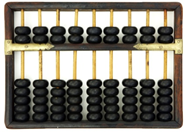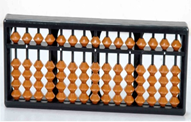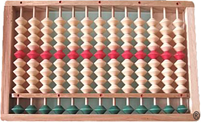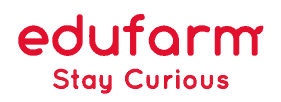3G ABACUS
The traditional abacus will require students to memorize 6 sets of complicated formulas, thus young children will find it very difficult to understand and learn them. Therefore 3rd generation abacus was invented, and it only requires students to memorize 2 sets of formulas, which students can pick up the skills faster. It is a strategy of helping children to learn math concept in a simplified way.
The 3G Abacus is made up of columns of 9 beads. This abacus is an improved version from the previous 2-5 beads (outdated, you can see them at a TCM store) and 1-4 beads (1 upper bead and 4 lower beads) abacus. With the 3G Abacus, students can pick up the abacus skills faster because the formula that a student needs to learn is much lesser. For the 4 beads abacus, they will need to learn 6 sets of formulae, but for 3G Abacus, students only need to learn 2 sets of formulae. It reduces the time they take to learn. The ultimate goal of learning Abacus Mental-Arithmetic is to achieve fast and accurate calculation, which 3G Abacus can help students achieve this goal in a shorter period of time.
 1st Generation |
 2nd Generation |
 3rd Generation |
|---|
1. Concentration: Your child will learn to perform basic calculations like add, subtract, multiply and divide, within their mind using a technique called “Visualition”. Visualization is a technique of imagining an abacus within our mind, and performs calculations as if you are performing it in the abacus. While your child calculates in their mind, they remembered each and every step with concentration and mental calculation. If this is progressively done, you child’s concentration will increasingly developed which will help him become competitive in their studies. Improving concentration also helps the child to focus on a specific problem. When the child is solving a mathematical problem in his mind, he focuses on reaching the ultimate goal-post of performing the last step of the calculation, i.e. fetching the answer, which is by and large always correct!
2. Analytical Skills: While your child solves a problem, he will analyze simultaneously on choosing the best method and formula to use in the problem. This will greatly improve his analytical capabilities. By this, your child can easily apply analytical techniques in real life problems from multiple angles in early years, which makes him more advanced than other children when it comes in analyzing situations and using the right approach for a problem.
3. Retention: Or other word, memory. When solving a problem mentally, a child needs to remember the answer in each and every step of the procedure. Which multiple aswers will be memorized in his mind. With the abacus, your child will subconsciously improve his memory in retaining answers, solutions, procedures and so on. This, in turn, helps the child in remembering and assimilating other information as well as subjects too with much of ease rather than spending much time and efforts to memorize the content.
4. Speed: With constant practice of the abacus, your child will solve problems mentally faster. One example scenario would be with a person with a calculator and a child who knows abacus. You will be amazed to see that the child is everytime at par in speed with that of a calculator, and many times, even faster than a calculator.
5. Confidence: We know math is not an easy subject for our children, but by abacus your child will overcome the fear of math. Through abacus, he will answer math problems accurately and in a much faster rate. With constant practice using abacus, it will make him confident to answer problems with his peer groups, home and in any situation.
This course can improve one’s memory and thinking skills, and it also inculcates an interest in mathematics in the student. One can also learn how to add, subtract, multiply and divide both using an abacus and using mental calculation very quickly through the course. It will help children who are in lower Primary in their understanding of number bond in Primary School Math.
The abacus we use is different. We use the 9 beads abacus, CMA uses the 4 bead abacus. As such, the formula that student need to learn is much lesser. For the 4 beads abacus, they will need to learn 6 sets of formulae, but for 3G Abacus, students only need to learn 2 sets of formulae. It reduces the time they take to learn.
It’s not about the number of hands. It’s about the outcome which is fast and accurate mental sums. To be strong in mental arithmetic, you will need to engage the visual part of your brain, which already means you need to use whole brain training.
3G Abacus has a set of comprehensive teaching materials specially designed for learners. Our materials are suitable from Nursery Level right up to advanced level learners. The teaching materials are progressive and helps student builds up foundation in speed and accuracy as the students progress to the next book.
This skill has proven to be beneficial in improving one’s mental capability, increasing one’s speed of response, memory power and concentration power. This course has become a compulsory curriculum in many countries such as Taiwan, China and Japan, and countries such as India, Malaysia and Singapore have introduced the curriculum to schools. Learning this skill will help to strengthen one’s mental power, an important asset in this knowledge economy.
Students can start learning 3G Abacus course from 5 years old onwards.
For 4 years and under, they can be accepted if they can write independently. If the child is able to write 0-9 independently, we will take him in. If cannot write, he may start when he is ready. A good age to join is actually 5 years and above.
We have different levels depending on the child’s age and readiness.We have different levels depending on the child’s age and readiness.
-
- For Nursery to Kindergarten 2 (4-6 years old), students will start from the Preparatory Course.
The Preparatory course a preparation program for them to go in Elementary Level, because in Elementary Level, they will start learning from formulae. So in Preparatory Course, we will build up their Number Bonds, Number Sequence, Place Values, and introduce the usage of the Abacus through simple sums. Total of 5 books, each book takes up to 10 lessons to complete depending on child’s speed. In Preparatory Course, if your child picks up the skills fast, he can skip levels according to his ability. - For Primary 1-6, students will start from the Elementary Level.
The Elementary course covers all the formulas needed to work on the Abacus. Mainly covers Addition and Subtraction, up to 2 digits. Towards the end of Elementary Course, we will introduce multiplication. 2 books, each book takes about 10 lessons to complete depending on the child’s speed.
- For Nursery to Kindergarten 2 (4-6 years old), students will start from the Preparatory Course.
At learning centres, students are usually grouped according to level. In RC/CC it can be mixed from 5-12 years old in the same class.
During our instructors training, we teach them how to teach mixed groups. They will usually be grouped into smaller groups within the class with the same level in each small group. The teacher will coach the children individually in each small group, and then allocate time to complete the assignment in class before going on to the next group.
Usually the work per lesson is 3-4 pages. The instructor will do teaching in class and allocate time for them to complete the work. If the student is able to complete the work in class (usually 80% of students can do this) then no homework for them.
For 3G Abacus, because we use the 9 beads abacus, the concept is actually same to the school’s method, (every 10 carry over). For our students, it actually helps them in their school work. Usually our students who has been with us for at least a year before starting P1 can achieve very good results in Maths (most of them score A in P1 Maths).
Usually if they start learning from Elementary Level (7 years old and above), most of our students can finish the whole course in about 2 years. If he starts from 5-6 years old, they might need to take more time (on average about 3 years), as they will be starting from the Preparatory Series.
Yes. Certificate of Completion of 3G Abacus Course will be presented to students once students completed the last module, Advanced III Module.Yes. Certificate of Completion of 3G Abacus Course will be presented to students once students completed the last module, Advanced III Module.
In the meantime, during the course of learning 3G Abacus, we also have Annual 3G Abacus Mental-Arithmetic International Grading Examination, where instructors will encourage students to take up the grade which is suitable for their learning stage. Upon passing the Grading Examination, students will be presented with Grading Examination Certificate for each grade they take.
All 3G Abacus Instructors are qualified to teach 3G Abacus Course. They have completed training up to Advanced Level, and have attained at least Mental Grade 3 and Abacus Grade 6 in the International Grading Examination. They have also completed our Instructors’ Training programme. Our instructors also attend our 3G Abacus Instructors’ workshop to upgrade themselves constantly.
Course Fees: $200 per term of 10 sessions
Material Fee: $30 (One-time payment for Abacus set & bag) + $12 for every book


